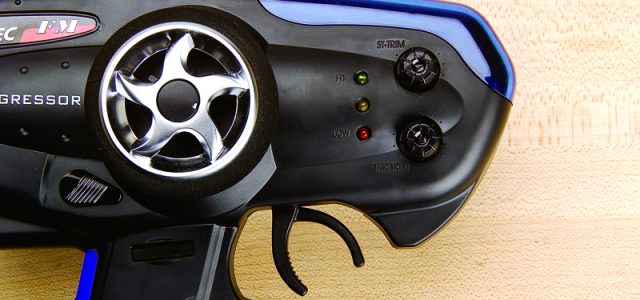Adjustable trim rate. If you’ve ever wished you could set how much servo movement you get with each “click” of trim, this is the function you want. By adjusting the trim rate, you can set the percentage of travel each click of trim represents.
Anti-lock brakes (ABS). The ABS function is invaluable when racing on slippery surfaces or when running cars with rear-wheel braking only. When ABS is set, applying the brakes will cause the servo to pulsate or to quickly engage and disengage the brakes for smoother, more controlled braking. Most ABS systems allow you to set the delay (the time it takes for the ABS to engage), the depth (the total travel of the servo during pulsing) and the speed (the rate at which the servo pulses back and forth).
Auto display. Radios with this feature automatically display the setting for the trim lever you’re using, so you don’t have to scroll through menus.
Auto start. The exact operation of this feature varies with brand, but in general, it lets you program a throttle position that the radio will automatically transmit as soon as the trigger is moved out of neutral. You might set it for 1/2 throttle as a traction-control device or for full throttle for a drag-style launch—or anywhere in between. Once the trigger has returned to neutral or the brake has been applied, the throttle function returns to fully proportional control.
Battery alarm. An alarm sounds when a radio’s battery voltage falls below its requirements for reliable operation.
Deadband. To prevent the trigger from being too “touchy,” all transmitters are designed to have a small area of trigger travel that will not transmit a forward or reverse command. This is known as “deadband.”
Direct servo control. A patch cord that is attached to the transmitter (TX) and the receiver (RX) allows you to adjust the servos or ESC (on an electric vehicle) without your having to turn on the radio and emitting a signal that can cause interference with others on the same channel.
Display-only mode. This allows you to turn on the LCD screen without sending a radio frequency (RF) signal. This is very useful for making radio adjustments in the pits when other racers share the same channel.
Dual rate. This allows you to alter the servo travel on both sides of neutral simultaneously, and it’s most often used for the steering channel. Unlike endpoint adjustments, which are made independently for left and right throw, dual-rate adjustments affect servo throw in both directions.
Endpoint. Endpoint adjustments allow you to set left and right servo throw independently. Adjustable endpoints are particularly useful for adjusting a nitro car’s throttle/brake servo because it may require significantly more travel to operate the throttle than the brake.
Exponential. This allows you to adjust the servo’s response around neutral. For example, if the expo is set for a negative value, the servo will respond less quickly to steering wheel or trigger movement near neutral. Conversely, it will respond more quickly as the limits of travel are reached. A positive expo setting does the opposite: it’s faster near neutral and slower as the servo reaches its travel limit. The greater the expo value, the greater the difference in servo speed, from slowest to fastest.
Fail-safe. This feature is only found on PCM radio systems. The fail-safe system returns the throttle servo or ESC and steering servo to neutral positions in the event of radio interference or loss of power to the model. This invaluable feature prevents the vehicle from going out of control if you encounter a glitch.
Frame rate. Frame rate is the speed at which the transmitter “fires” bundles of information to the receiver. Most pro-level radio systems allow a faster than usual frame rate to better exploit the superior processing speeds of digital servos.
Frequency modulation (FM). Provides cleaner, more reliable reception than amplitude modulation (AM) systems and is preferred by racers because FM systems are less prone to glitching at the track. Also referred to as “PPM.”
Idle up. This is used exclusively for nitro-powered cars. When idle up is selected, the throttle servo moves to a position you set to speed up the idle for easier starting or warmup. When idle up is switched off, the throttle servo returns to the designated neutral position.
Mixing. This feature allows you to “mix” the transmitter’s channels so that the throttle will also influence steering or vice versa. This function is rarely used with cars, but it is popular with boats; a little rudder is often mixed with the throttle to prevent the boat from pulling to one side when it accelerates.
Model memory. Lets you store the data for multiple models and various setups for the same model in the transmitter’s memory. Each mode and setup is assigned a model number. Some radios also have model “naming” capability, so you can call up a model by name.
Operation/count-up/countdown/lap timer. This tells you how long your radio has been switched on, and that helps you to monitor the battery condition. A count-up timer counts up from zero and is good for monitoring run time. A countdown timer counts down from your set time to zero, and it’s good for timing a race. Such a timer is especially useful when you’re stuck with a pesky announcer who never tells you how much time is left on the clock; the lap timer counts individual lap times (of course!).
Servo-reversing. All transmitters have this invaluable feature so you can reverse the servo’s operation by simply touching a button.
Servo speed. You can’t increase a servo’s speed with this function, but you can slow its transit time. If your new super-servo makes your car feel twitchy, or having a lightning-quick servo is a liability, e.g., in oval racing, try adjusting servo speed.
Subtrim. A very fine trim function—if one “click” of the trim is too much, the subtrim allows you to make a more precise, smaller adjustment.
Trim. When you adjust the neutral point of the servo’s output arm, you are adjusting its “trim” or “trimming” the servo.
User-assigned controls. The digital trim levers or buttons of some computer radios may be assigned different functions to suit your needs; for instance, the knob assigned at the factory to dual-rate adjustment may be reassigned to operate the brake trim.
Wheel tension. A mechanical adjustment of the force required to operate the steering wheel.








![RC Car Action - RC Cars & Trucks | This 1/3 scale 125cc V10 Buggy is CRAZY [VIDEO]](https://www.rccaraction.com/wp-content/uploads/2018/05/V10-HP.jpg)


 Stay up to date with the latest information, sign up for our FREE newsletter today.
Stay up to date with the latest information, sign up for our FREE newsletter today.
